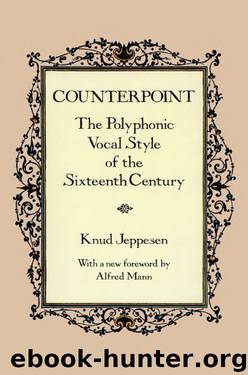Counterpoint: The Polyphonic Vocal Style of the Sixteenth Century (Dover Books on Music) by Knud Jeppesen

Author:Knud Jeppesen [Jeppesen, Knud]
Language: eng
Format: epub
Publisher: Dover Publications
Published: 2013-04-15T03:00:00+00:00
MELODY
The polyphony of the Palestrina style rests essentially upon simultaneously sounding melodic lines; its basis is melodies.
These melodies differ in many respects from the concepts associated in more modern times (eighteenth and nineteenth centuries) with the word melody. In the first place the treatment of intervals is much simpler and stricter. All chromaticisms and all dissonant skips are avoided, and the attitude toward the rhythmic-metrical problem is proportionately less one-sided. The IPalestrina music moves in free, prose-like rhythms in contrast to the poetic, strict rhythmic pattern of the eighteenth and nineteenth centuries (especially that of the Vienna classicism) with its accurately measured symmetry (the constructive material consists chiefly of groups of from two to four measures) which, if carried to extremes, can be unbearably conventional and limited.
The linear treatment of the Palestrina music reveals a marked inner coherence and an understanding of what is, in the truest sense, organic, which is indeed sought after in every style species. It abhors the rough and inelegant and rejoices in the free and natural. It avoids strong, unduly sharp accents and extreme contrasts of every kind and expresses itself always in a characteristically smooth and pleasing manner that may seem at first somewhat uniform and unimposing but that soon reveals the richly shaded expression of a superior culture.
According to a famous Italian Renaissance architect, Leone Battista Alberti, “Beauty is a sort of chordal combination, a harmony between the different units which does not allow anything to be added or taken away without having an injurious effect upon the whole.” This definition applies also to the Palestrina music, in which the constructive sense is strongly influenced by the viewpoints of the late Renaissance. In contrast to the often somewhat fantastically diffuse style of the middle ages, the Palestrina style rested on the principle: not a single note too many or too few. All details must unite in entirely undisturbed harmony, must fuse into a higher unity in spite of individual independence. An absolute, completely free balance between the elements was required; no one element could be emphasized at the expense of another; everything must work together smoothly and harmoniously. Let us examine one of the melodies of Palestrina: the beginning of the upper part from his five-part offertorium Ave Maria:
Download
This site does not store any files on its server. We only index and link to content provided by other sites. Please contact the content providers to delete copyright contents if any and email us, we'll remove relevant links or contents immediately.
The Goal (Off-Campus #4) by Elle Kennedy(13213)
Kathy Andrews Collection by Kathy Andrews(11346)
Diary of a Player by Brad Paisley(7272)
What Does This Button Do? by Bruce Dickinson(5938)
Assassin’s Fate by Robin Hobb(5867)
Big Little Lies by Liane Moriarty(5528)
Altered Sensations by David Pantalony(4878)
Pale Blue Dot by Carl Sagan(4633)
Sticky Fingers by Joe Hagan(3918)
The Death of the Heart by Elizabeth Bowen(3350)
The Heroin Diaries by Nikki Sixx(3328)
Beneath These Shadows by Meghan March(3157)
Confessions of a Video Vixen by Karrine Steffans(3110)
The Help by Kathryn Stockett(3024)
How Music Works by David Byrne(2969)
Jam by Jam (epub)(2882)
Harry Potter 4 - Harry Potter and The Goblet of Fire by J.K.Rowling(2818)
Strange Fascination: David Bowie: The Definitive Story by David Buckley(2704)
Petty: The Biography by Warren Zanes(2579)
